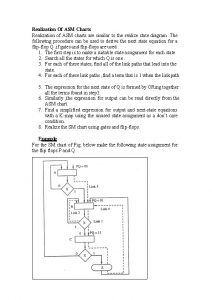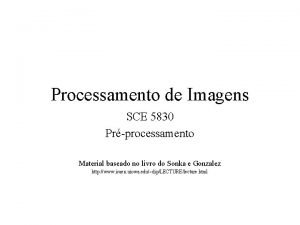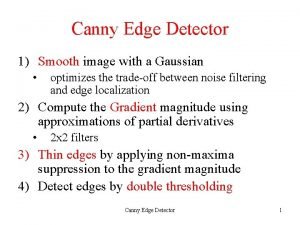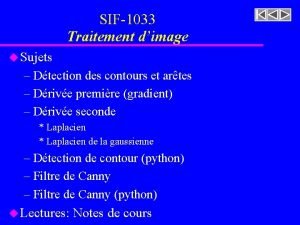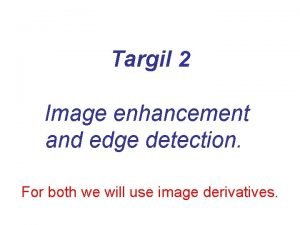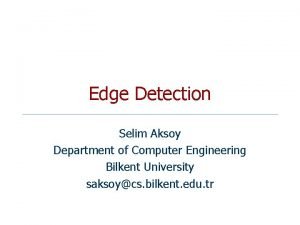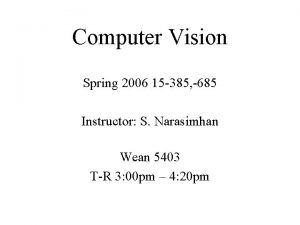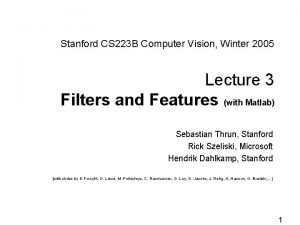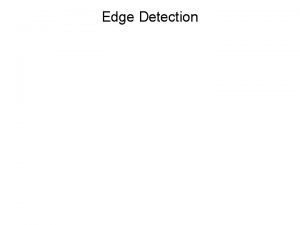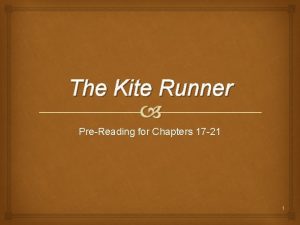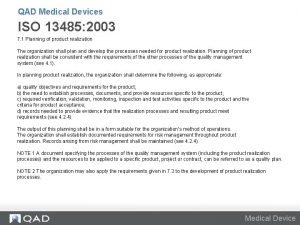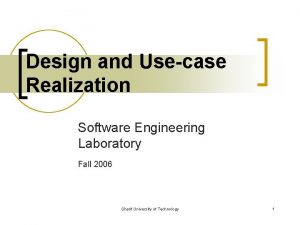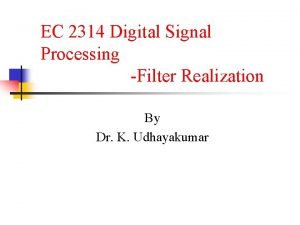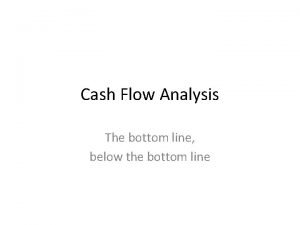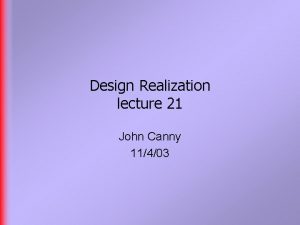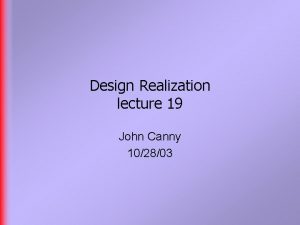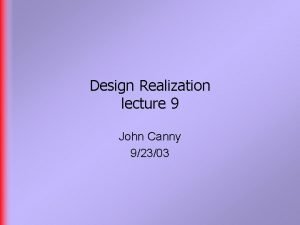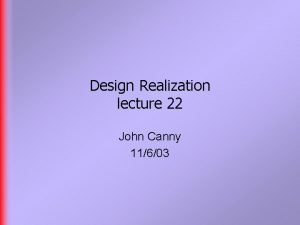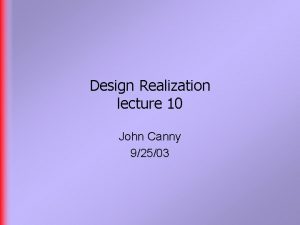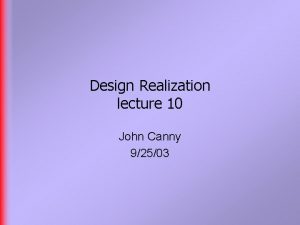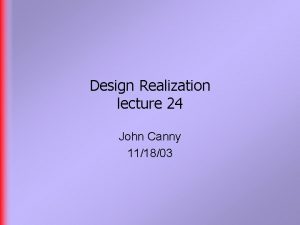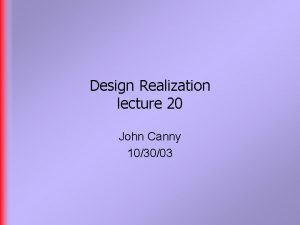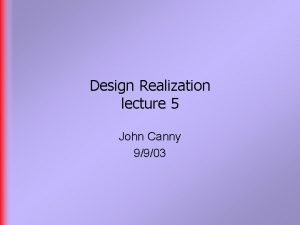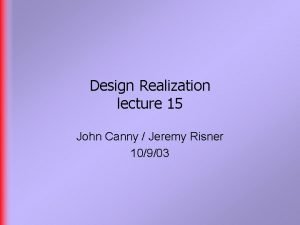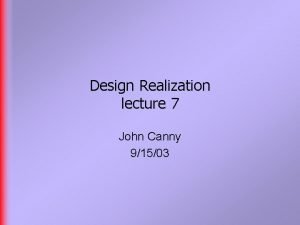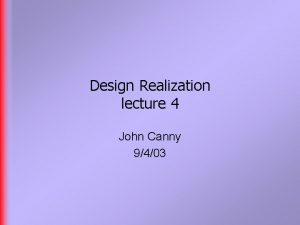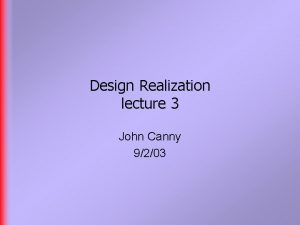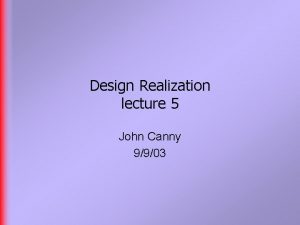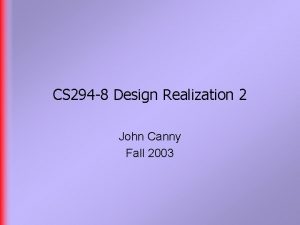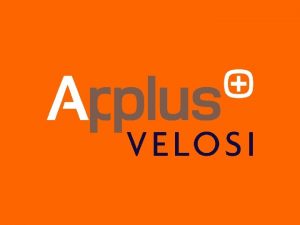Design Realization lecture 21 John Canny 11403 Last






























- Slides: 30

Design Realization lecture 21 John Canny 11/4/03

Last time § Mechanics § Physics revisited § Electric motor characteristics

Next time § Assignment review/crit. Please bring a graphic of your board design and schematic.

This time § Some more physics: § Bending and stretching § Construction methods: § § Molding Welding Structural components Modular systems

Bending: moment of inertia again § The 2 D moment of inertia about the x-axis is b § For a rectangle: h y x

Bending of a beam § We can make a beam bend by applying a moment (torque) to its end. The radius of curvature satisfies: M y which is r for a rectangular beam. E is the elastic (Young’s) modulus. z

Beam “spring” § The vertical displacement of the tip t is approximately t L 2/2 r L t § The bending moment due to force F at tip is M=FL § The spring constant at the tip is k = F/t which is M r

Beam stretching § On the other hand the spring constant for stretching a rectangular beam is: § Compared with the bending spring constant which is: § The ratio is h 2/6 L 2. Assuming L >> h, the beam is much stiffer in stretching than in bending.

I-beams and honeycomb § Bending stiffness can be increased by moving material outward (h 3 term). § This is the principle of I-beams and honeycomb.

Mass-spring systems § A mass at the end of a spring can vibrate with a natural frequency which is

Example § Vibration in linear actuators: § Natural frequency of the cantilever, ¼” Aluminum, is about 100 Hz (!)

Example § Diagonal bracing: § Bending becomes a streching mode. Natural frequency increases to over 1 k. Hz

Vibration in plastics § Metals have relatively low loss when deformed. Vibration is often an issue. § Plastics have much higher loss, so vibrational energy dissipates much faster.

Making shapes: sculpting § Molding kits are available from Tap Plastics and others. § Two part epoxy “magic-sculp” provides a claylike consistency for about two hours, then sets to a hard plastic model. § The model can still be worked when hard by cutting or sanding.

Making shapes: molding § From a plastic, wood, or metal model, a negative mold can be cast from a flexible plastic such as silicone or urethane.

Making shapes: molding § From the negative mold, copies can be cast. The casting materials are typically urethanes or polyester. Can be clear or colored.

Attaching shapes: Gluing § For plastics, glues are available that closely approximate the strength of the original plastic. § This generally gives best results. Excessive strength in a joint can create strain in the material near the joint.

Attaching shapes: Gluing § Many glues are available for wood. At the high end, epoxies are stronger than the wood itself. § Woodworking “yellow glues” provide very good performance as well and have similar strength to the wood being joined. § Dowels or dovetailing can be used to increase the contact surface – but may not necessarily increase strength.

Welding § Welding is joining pieces of similar metal using molten material of the same type. § The most common joining weld is a “fillet weld”

Welding § The size of the weld adds strength. § The shape of the weld relieves stress that can occur at sharp concavities in a part.

Arc Welding § Creates a thick weld using flux/wire which is part of the electrode:

Oxy-Acetylene Welding § Oxygen-Acetylene torch creates heat, flux/wire is fed separately: § Aside: Oxy-acetylene often used for cutting

MIG (Metal Inert Gas) Welding § Aluminum oxidizes instantly in air and requires an inert gas during welding. MIG welding uses an arc surrounding by gas flow (e. g. Argon).

Spot welding § Normally used to join sheet material. § Sheets are placed together and very high current passed through the join.

Truss systems Trussworks Inc.

Truss systems § Come in either aluminum or steel, 2, 3, 4 -leg. § Fast-connect screw connections between elements.

Modular construction systems § Can be used to build artifacts from linear pieces.

Modular construction systems § “T-slot” systems comprise extruded aluminum beams that are joined using standard fasteners. Examples of “Minitec” framing:

Modular construction systems § Joining Minitec elements:

Modular construction systems § Minitec includes active elements (motorized motion stages):
 Asm chart
Asm chart Imagem de uma rampa fonte max pixel
Imagem de uma rampa fonte max pixel What is canny edge detection in image processing
What is canny edge detection in image processing Traitement dimage
Traitement dimage Targil seasoning
Targil seasoning Joe canny
Joe canny Canny
Canny Canny
Canny Canny sebastian
Canny sebastian Canny mask
Canny mask 01:640:244 lecture notes - lecture 15: plat, idah, farad
01:640:244 lecture notes - lecture 15: plat, idah, farad Randy pausch last lecture summary
Randy pausch last lecture summary Touching spirit bear chapter 20
Touching spirit bear chapter 20 Farzana kite runner
Farzana kite runner Iso 13485 product realization
Iso 13485 product realization Use case realization example
Use case realization example Self realization aristotle
Self realization aristotle Use case realization
Use case realization What is use case realization
What is use case realization Ec2314 digital signal processing
Ec2314 digital signal processing Cash realization ratio
Cash realization ratio Calculate time interest earned
Calculate time interest earned Cognitive provides various channels for self-realization.
Cognitive provides various channels for self-realization. Corbiran
Corbiran Eurocode lap lengths
Eurocode lap lengths Urban design lecture
Urban design lecture Principles of design in interior design ppt
Principles of design in interior design ppt Lecture hall background
Lecture hall background Game design lecture
Game design lecture Computer-aided drug design lecture notes
Computer-aided drug design lecture notes Cmos vlsi design lecture notes
Cmos vlsi design lecture notes
